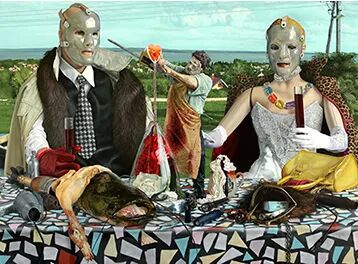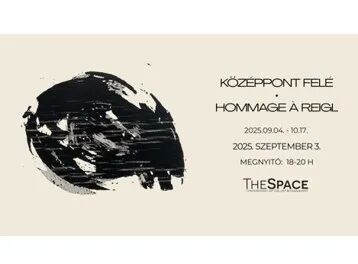"My Dear Friend, You have given me one of the greatest miracles of my life: you cannot imagine what a great and profound joy I felt this morning. The moment I saw your work, I knew it was one of the most sacred things in the world, and I took it as a sign of celebration that it came into my home." That was how André Breton, the domineering high priest of surrealism, paid homage in his letter to the greatness of the movement's new favourite, the daisy-fresh and young Judit Reigl, who had defected from communist Hungary. I believe that seventy years later, Peter Horn felt something of the same thrill (as Breton did that morning in Paris) when he took home his first Reigl painting from the gallery on Falk Miksa Street. Even if he did not bring back a surreal, early work, but an éclatement, an outburst in which Reigl smeared the abstract paint mass on the canvas with the curve of the curtain rod. And the first love was followed by others, massive mass writings, circular centres of dominance, then lyrical processes and falling men, throughout the whole oeuvre.
***
Each collection is a metaimage. A self-portrait, made up of many, many works. This ancient wisdom of art history cannot be argued with.
Each collection is a self-portrait. Even when the semi-automatic gestures of effortless trends sketch the portrait of the connoisseur, but especially when a visceral urge from within draws the lines, one after the other, relentlessly, for more than two decades. The identity of the Horn Collection belongs to the latter (much smaller) camp. Black portrait. Dark and solemn. Arbitrarily dramatic and dramatically arbitrary. Due to her significance in art history, it was Judit Reigl, a tenaciously determined, charmingly original artist, who drew the most important, irreconcilable features into this portrait of the collector. She drew it with curtain rods or with a curved blade, which she used to smear the sprayed paint in her Paris studio.
Reigl's canvases are always death fugues, the deep baroque organ sound of Bach concerts, while on the surface light French gestures dance like a rainbow. Horn fell in love with the elderly lady at a time when investors looking for sure tips didn't even know her name. Today, a hi-tech art warehouse houses the collector's treasures that the art trade has placed in recent decades on the highest shelf that Hungarian artists deserve.
In the warehouse, the computer system keeps the oxygen level so low that the chances of ignition and fire damage are reduced to zero. I think these gloomy black, solemn canvases enjoy the airless dark warehouse space. They secretly converse with their former Parisian confidants, the François Fiedlers. If anyone missed the dirt-canvases stamped with the studio junk layered like paint guano in the otherwise awe-inspiring Reigl collection, Fiedler's thickly plastered, cracked, tortured surfaces make up for those. A serious and elevated post-war Parisian abstraction, Reigl is a worthy companion in the matter - and a striking element of the collector's portrait. To these two I would add a third name, somewhat arbitrarily, that of Dezső Váli, whose cramped studio on Margit körút is far from the glamour of the Parisian monde de l'art, but is nevertheless linked to it by his imagery, its muted colourism, its introspective existentialism and its elevated humanism in general.
Returning to the collector's portrait, the fascination of the école de Paris, the late tachist paintings of Kolos-vary Sigismond and Antal Bíró, and the works of Sándor Molnár, who smuggled post-war Parisian abstraction over the Iron Curtain to Zugló, are striking. An obvious choice. What is more, we are not talking about a small number of paintings! Ernő Kolozsváry, one of the greatest aces of Kádár-era semi-secret art collecting, taught us that we should collect complete lifetime works, with a cross-section of major works, tailored to each artist, showing a career path, with the strongest possible masterpieces. Péter Horn, who began his professional career after the fall of communism and his collecting career after the turn of the millennium, follows this school, more unconsciously than consciously. A noble tradition.
***
While running the company, Peter Horn was actively trading shares, undeniably successfully. He considered himself a fundamental investor, looking for undervalued stocks. Just as he later began hunting for undervalued painters in the art market. He did not follow the herd from the gallery stalls, but his own instincts and his own desire to explore: he scoured the estates, the fading stock of Parisian galleries and the nooks and crannies of distant auction houses. When the collector's Sturm und Drang seemed to fade, when the first great era of artwork gobbling and acquisition had subsided, there was a moment of perplexity. Then nocturnal youths attuned to black drama appeared on the moonlit horizon. (I suspect that after the sterile, Germanic laboratory purity of the health industry, Peter Horn also has an instinctive craving for black, human filth.)
Out of the blackness of the coal dust murky figures emerged. From the depths of the Szolnok artists' colony came György Király, with his softly touching brush moves with Morandi pots and monochrome night still lives, or the undergraduate Norbert Bálint with his Mednyánszky dark, boxer-nosed homunculi, the post human visions of Róbert Lak and the smeared, blown-up gestures of Botond Kuti from Transylvania.
The young people add an extra touch of muted colour features to the collector's portrait, alongside the great Parisian geniuses.
***
The gestural order of the sombre undertones in the collection's portrait is matched by frivolously raw photorealistic features. István Sándorfi and István Nyári add the microscopic brushstrokes. Arrogantly and cruelly. Somehow, the hearts of photo-realists are always hardened, because collectors bow to them, but at the same time curators who are demanding intellectually show them the door. Sándorfi refused the label of hyper-realist while painting himself, on slide film like yellowish-blue, precisely silky surfaces. Randomly appearing crotches, nudes wrapped in blankets. Coolly sterile, seedless painting, too good to be true. Chillingly honest, each painting emits cool air, like a cellar vent.
Next to it Nyári's bizarrely tuned giant canvases are lined up: perfect reflections of the illusion of the spectacle, created by sinuous, tiny line flows. A masked honeymoon couple over a plastic tablecloth, tigers among the led garlands, a Japanese girl escaping into a tulip field in the solitude of a chat window. Transparent nylon gloves play Reigl's death fugues on the keys of a laptop keyboard. Perfectly formed, artistic gestures: artificial supplements favoured by the robust collector added in the form of protein powder to the black masterpiece soup of the collector's self-portrait. A little Blade Runner protein thrown into the vortex of existentialism.
***
One fine day, Hugo Scheiber knocked on the door of the Horns’ house in Újlipótváros (To be historically accurate: Peter Horn's grandparents' house.) He wheezed and kept wiping his forehead with a handkerchief. His growling stomach chased him. He left his picture with the family for the sum that can buy a bowl of lunch. The shady, tree-covered park walkway now rests in the clutter in Peter Horn's workroom. If you're going to be a collector, it doesn't hurt to be born into a good family, where there is a value and tradition of the respect and love for art! With its curvilinear lines and decorative fabulousness, the inherited Scheiber painting is the only visual link to the populous camp of Roma painters. But as far away intelligentsia’s Újlipótváros is from the gypsy slums in Salgótarján, as striking of a blotch of colour is created by the Roma naives of the seventies in the painting collection.
Of course, János Balázs steals the show, the big pioneer. More than half a hundred works, the entire career arc can be told through them. Which is not a very long story. János Balázs, the old, eccentric Roma sage, was discovered by intellectuals hunting for naive voices in his adobe hut in Pécskődomb in the late sixties. Encouraged by them, he began to paint again with the tools he had been given and to write poetry, and journalists, art historians and film-makers thirsty for an individual voice made pilgrimages to him. After nearly a decade of appreciation, he passed away; his intellectual legacy and the popularity of his paintings fell or climbed back into the horizon of visibility depending on the general perception of Roma painting. We can think of no more unexpected pairing than the Salgótarján naivety associated with French gesture painting, the belle peinture. Thick outlines, variegated Indian colouring, carpet-like pictorial construction, sprawling mythology. And János Balázs is not alone, the collection also includes Balázs András Balogh, who rises (and then falls back) from deep poverty, following in his footsteps. Another Roma painter who created his pictorial world at the same time. In it, the beggars, torn from their branches and snaking like tongues of flame, standing in small straddles between the huts made fabulously beautiful and the trees brushed to be ornamental, with depressing black bases in front of their backs. To round off the story, we also find in the company the intellectual gypsy painter Tamás Péli, who attended the Royal Dutch Academy of Fine Arts and, on his return home, played an important role in stimulating the Hungarian Roma intellectual life and art world, but the source experience of his paintings were always the 'black' people around him.
Magical realism and Roma mythology. Bright splashes of colour on the portrait emerging from the collection. They would stand here as a lonely enclave if we could not associate them with another forgotten hero of the time, László Drégely, who, as a much-employed set designer, created his large-scale, truly retro painting in the depths of the Kádár era. Chagall splashed up with Béla Kondor, a dash of Endre Bálint. Women's silhouettes, menorahs and angel-winged clocks selected from the complete oeuvre. On Drégely's gaudy dials, the hands of the clocks froze as they approached - darkening - midnight. Thus he defied the cruel time, the death that lurks before us. "What does the clock mean? Perhaps a little bit the flying time, the cruel time. Reminds us a little of passing," he explained. Just as an art collection confronts the passing of time, the works of art weave their creators’ features into a large collective portrait of time. Their hopes and desires. Their intellectual heritage and their hunted prey.
Gábor Rieder




